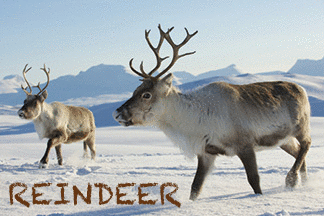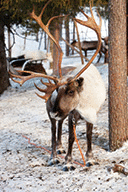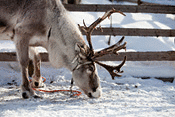

During the Christmas season when Santa Claus is making his yearly appearance in a wide variety of commercial appeals, there is frequently a group of reindeer surrounding Santa and perhaps even pulling a sleigh. I recently heard an exchange between a heckler and a department store Santa in which Santa was asked why he did not use Michigan whitetail deer instead of reindeer. The response was that the reindeer union was weaker at the North Pole so he could get them cheaper. Actually, reindeer are highly specialized animals that function beautifully in an environment where our Michigan deer would not stand a chance. While they are not at the earth's North Pole, reindeer live in a brutal climate with extreme conditions.
One obvious problem in a polar environment is the cold temperatures. Just inhaling when the air is 20 degrees below zero can be a destructive action. The reindeer nose has a long, narrow, bone structure called a turbinate bone which increases the surface area allowing air to be warmed before it enters the lungs. Water in the air is condensed and captured as the reindeer breathe. This allows the moisture to be absorbed into the blood through mucous membranes.
Daytime and nighttime are strange in the Arctic Circle since the sun is up for a matter of minutes in the winter and virtually all day in the summer. Most animals, and people, have a circadian rhythm that is based on changes in light during the day. This internal clock tells us when to sleep, when to wake, and directs other body functions. Reindeer have no circadian rhythm, so they do not function on a 24-hour clock. Their activity during daytime or nighttime is determined by other factors, not by an internal clock. The long days and long nights are not an issue for reindeer as it would be for other animals. Reindeer have eyes that are specially designed to be sensitive in the ultraviolet range. This allows sharp vision in the harsh light on the snow, and it allows the reindeer to see things critical to its survival. A white wolf in the snow is readily visible to a reindeer even though its color is ideal for camouflage.

Traveling in the tundra is a special challenge. I have personally tried to walk on the tundra at different times of the year, and I can tell you how difficult it is. Tundra is soft, and you sink into it in summer. In the winter it is hard with crusty snow and ice making it very slippery. Reindeer have footpads in summer that are soft and spongy. This gives them traction in the tundra. In winter the pads of the reindeer shrink exposing the rim of the hoof which will cut into ice and crusted snow to give traction. The reindeer dig into the snow to find lichen (called reindeer moss) leaving a depression — a process called “cratering” by the people who live in the area. Reindeer can run up to 40 mph and at one-day old they can outrun a human. If threatened, they can swim from 4 to 6 miles per hour.

As reindeer walk, their knees click due to tendons slipping, and the size of the knee determines the loudness of the click. Reindeer use this to determine dominance, and the social structure of the herd is uncontested because of this. Animals this specialized are designed for a very specific environment. The reindeer design features allow them to exist in a place that requires an intelligent system planned to meet specific needs. God's wisdom is displayed in a special way in the reindeer.
Picture credits:
© Dmitry Chulov. Image from BigStockPhoto.com
© Bottom two photos: Molka. Images from BigStockPhoto.com
